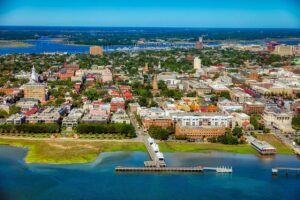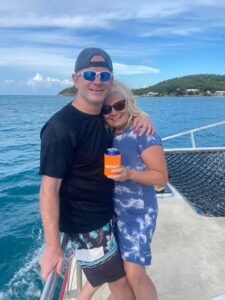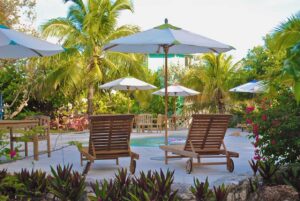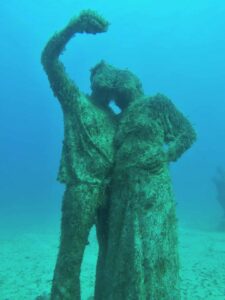Paying $1,000 to get into a country to experience both a volcanic eruption and a Category 1 hurricane might not be anyone’s idea of the perfect holiday, but that’s exactly what we got during our time in the Grenadines. Include a whale hunt and a broken foot, and the list of our experiences is complete. Regardless of the rap sheet, if you ask, “How are the Grenadines?” I’ll say magical. Even the wrath of nature hasn’t damaged the beauty that it holds.
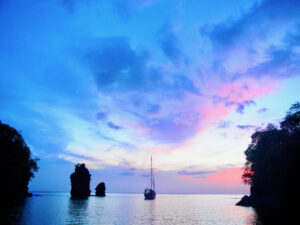
Given the complexities of entry protocol during COVID, movement between Caribbean countries is now both a costly and lengthy process. Tiring of expensive PCR tests and long quarantine periods for a short amount of time in a small cruising area, we were in search of a cruiser’s Garden of Eden where we’d have freedom of movement within a large group of islands. With 32 islands in the group, we’d found what we were looking for: the Grenadines was our Eden.
We entered in early April, excited to spend a few months exploring this popular cruising destination. With a wide variety of islands, ranging from the pristine beaches of Tobago’s white sand cays to the wildness of St. Vincent’s black sand shores, the Grenadines offers plenty of diversity for those eager to explore. After two weeks in quarantine, we were eager.
All thoughts of a leisurely cruise through a tropical paradise were unexpectedly stunted in our first week in the country. No sooner were we released from quarantine when La Soufrière, St. Vincent’s northern-most volcano, erupted. We were in the neighboring island of Bequia when the sky slowly filled with an ominous plume of expanding ash.
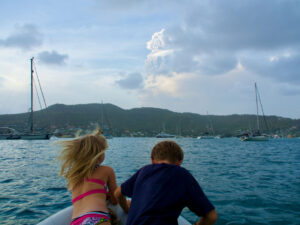
By morning, every palm-fringed, white sand beach throughout the Grenadines was covered in a thick layer of toxic ash. The vibrant, aquamarine water was muted by a thin layer of grey film. Streets were empty and towns were deserted. Having just entered our Eden, our aquatic garden looked like the inside of an incinerator.
We passed a succession of ghost islands along with a long line of other sailboats as we raced south to get clear of the toxic rainfall. After a few days of inhaling volcanic soot and scrubbing grit from my teeth, the winds changed direction and the thick grey haze finally cleared.
Our Eden looked a bit dusty and rough around the edges, but the picture-perfect beauty of the Tobago Cays slowly reemerged. The seven small islands that make up the Cays surround an inner lagoon and are protected by a wide outer reef. Here we settled into true island life, swimming with the turtles and rays that populated the anchorage and gathering ashore with the other cruisers in the evening on uninhabited beaches.
Over the next two months we slowly explored every palm-fringed islet and every sandy cay as we made our way back through the chain of islands. Each subsequent bay became our new favorite, and we soon settled into a leisurely routine of swim, rest, drink, sleep — the epitome of the perfect Caribbean lifestyle. Eventually bliss and leisure weren’t enough to keep us contented; it was time to shake the sand off our backsides and add some punch to our cocktail existence. I needed an adventure.
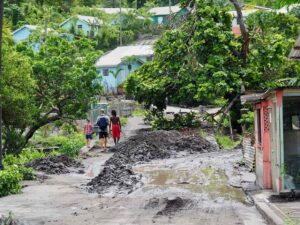
We’d covered every island south of St. Vincent, but we hadn’t yet explored the main island, the northernmost and largest of the group. A little research suggested that the volcano had stabilized and the “red zone” — the area most affected by the volcano — was no longer restricted. When looking for excitement, why not start at the heart of the disaster?
St. Vincent is geographically different than the rest of the Grenadines, which are a collection of smaller islands with arid shrub-land, flat, wide-open bays and white sand beaches. The main island is lush, verdant, rugged and wild. First-century petroglyphs that were left by the Amerindians were carved, it is suggested, in response to environmental threats such as hurricanes and volcanoes that were never encountered. I thought it suitable that I seek these out in the wake of the recent eruption.
The island is also known for its extensive rainforest and the rivers and waterfalls that run through it. While officially closed due to COVID, we were able to hike through the forest and stand under a few of these impressive falls. We stern-tied in tiny bays where sheer cliffs provided exhilarating rock jumps and swam through deep fissures in the rock.
We sailed up to the far north of the island where most of the volcanic fallout was visible and took in the scarred earth: pyroclastic flows carved deep paths down the mountain, redirected riverbeds dumped muddy ash into the ocean, and acres of fallen trees lay blackened and scorched across the land.
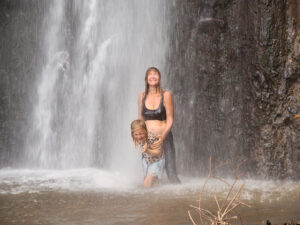
While our trip up the west coast of St. Vincent was filled with adventure, nothing was as unexpected as the whale hunt in Barrouallie Bay. While I understood it was practiced, I didn’t expect that we would witness the hunt and kill of the “blackfish,” the local term for pilot whale. Five whales were dragged into the bay by small, motorized skiffs with a sawed-off gun mounted on the front.
We were allowed to watch as teams butchered the animals, prepared the meat for drying and boiled down the fat into oil. While I am morally opposed to the practice, it was culturally fascinating to talk to the locals about their deep affinity for the meat, particularly the blubber which is revered as an elixir of life and a cure to all ailments, including, they assured us, for COVID.
After languishing on the idyllic palm-fringed white sand beaches of the smaller islands, sailing up the west coast of St. Vincent was like dropping into the other side of the world. This was more than a Garden of Eden: It was a beautiful garden that backed up onto a magical forest, offering us the perfect combination of serene tranquility and high adventure. When choosing St. Vincent and the Grenadines, we couldn’t have picked it better.
Photos by Kia Koropp


